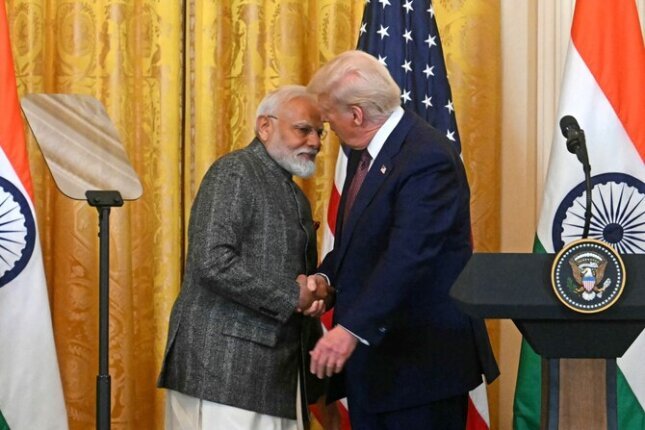India Gamble: Will Trump’s Strategy Backfire?
 US President Donald Trump shakes hands with Indian Prime Minister Narendra Modi during a joint press conference in the East Room of the White House in Washington, DC, on February 13, 2025. (Photo by Jim WATSON / AFP)
US President Donald Trump shakes hands with Indian Prime Minister Narendra Modi during a joint press conference in the East Room of the White House in Washington, DC, on February 13, 2025. (Photo by Jim WATSON / AFP)
By: Rabiea Raziq (Research Scholar)
For the past two decades, United States has been taking a huge gamble in the Asia Pacific— that treating India as a major partner will help the US secure its geopolitical interests in the region. US administrations have augmented India`s military capabilities, from George W. Bush onwards. In their comprehensive joint statement at the White House during Indian Prime Minister Narendra Modi’s recent visit to Washington, Trump and Modi agreed to impart a fresh momentum to their defence cooperation by facilitating the transfer of advanced military technologies to India.
The two sides reaffirmed their commitments to fighting terrorism, but added a Pakistan-specific reference that has no basis. Continuing the legacy of the policy of the Biden administration toward the region and ending with sanctioning Pakistan’s missile program without any role in promoting broader regional interests, this once again raised the issue of biased South Asia policy of the Trump administration.
US president ignores India’s sponsorship of terrorism, subversion, and extrajudicial killings in the region and beyond, and hate crimes against Muslims
Once more Washington has decided to turn a blind eye to the obvious threat posed by the bolstering of India`s military capability and aggressive policies. Instead, it is supplying advanced military technologies to India including the sale of cutting-edge fighter jets which, will make India part of an exclusive club of countries, including the NATO-allied countries—Israel and Japan—who have been granted permission to buy the F-35s, known for their stealth and supersonic speed.
The US president, through expansive discussions, is not surprisingly ignoring India’s sponsorship of terrorism, subversion and extrajudicial killings in the region and the world and hate crimes against US Muslims and other minorities in India, by keeping effective silence. The killing of a Canadian citizen on Canadian soil, along with a plot to kill an American citizen, has already exposed India-state-sponsored terrorism.
Moreover, the US is ignoring Indian government’s atrocities in the Indian-occupied Jammu and Kashmir (IIOK), where unarmed civilians are being martyred and tortured daily by the occupation forces, and keeping silence over India’s non-implementation of the UNSC resolutions. Sadly, in utter disregard of international law and the UN Charter, the Modi fascist Indian government is following its hegemonic designs which poses a threat to international peace and security.’
In view of the region`s past, marred with major wars, and the never-ending hostility between the nuclear neighbours, an impartial South Asia policy is what the US needs to embrace
In the talks between Modi and Trump, they also “pledged to work together to counter the proliferation of weapons of mass destruction and their delivery systems and to deny access of such weapons to terrorists and non-state actors.” US military support to India is in direct contradiction to the well articulated goals of the global non-proliferation regime and the US internal commitments to multilateral non-proliferation efforts. These would only subvert already meager arms control regimes, as well as global non-proliferation efforts.
The US ongoing assistance to India, on the other hand, is adding to a strategic imbalance in South Asia: It is deepening India-Pakistan rivalry and Pakistan’s threat perceptions, while fuelling the regional arms race and action-reaction syndrome. The Indo-US defence cooperation has had an impact on existing treaties preventing establishment of meaningful dialogues and cooperation as the US favours its national preference over the collective.
The US has become an active participant in India`s military modernization at the cost of regional security and stability. India also needs to be held accountable for its development of nuclear-capable long-range missiles, which is a threat to global peace and security along with its poor safety and security record of nuclear weapons and aggressive military posture.
The complacencies of national identity lead into the idle invention of the impending conclusion of nationhood.
Among the current cascade of precarious tensions facing Pakistan and India, Pakistan and India are already dangerously poised for nuclear escalation: institutionalized confidence-building measures (CBMs) are spotty if not absent; Islamabad and New Delhi’s diplomatic ties have been suspended; and the Indian government’s hawkish military posture in South Asia has alarmed not only Pakistan, but also India’s neighbours. In this uncertain security environment, strategic stability is key not just to peace and security in the region but also to global peace, due to the possibility of an escalation between the two nuclear-armed neighbours that could engulf global peace as well.
It is only deepening military asymmetries in South Asia by providing India with sophisticated military hardware. And considering South Asia is a historical theatre of major wars and the perennially bitter competition between the two nuclear-armed nations, the debts of the unresolved disputes continue to threaten peace and stability in the region, an unblemished objective policy from the US is the need of the hour. Pakistan should not forget how Pakistan fought a 20-year-long battle with the US, which reflected in economic losses for Pakistan. Moreover, it cost thousands of its own people their lives.
In the short run, the US must stop supplying India with advanced military technologies with widespread ramifications. This is why the Trump administration must encourage and support peace and stability initiatives in the region. Finally, Pakistan has no choice but to keep the credibility of its nuclear deterrence to counter Indian threats at all levels.


